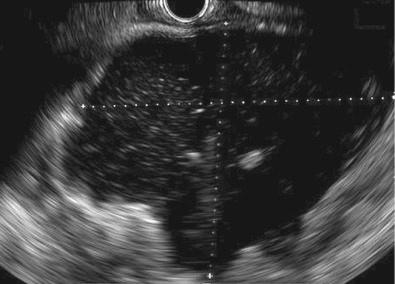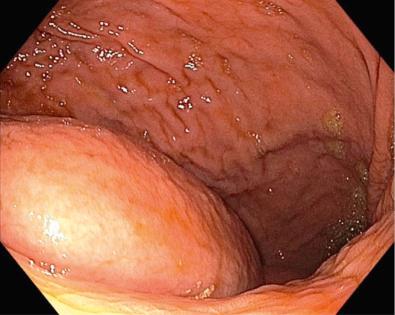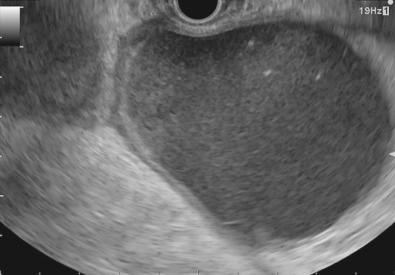Physical Address
304 North Cardinal St.
Dorchester Center, MA 02124
Pancreatic fluid collections (PFCs) and leaks develop due to main or secondary pancreatic ductal disruption caused by acute or chronic pancreatitis, trauma, or pancreatic surgery. PFCs include acute fluid collections, acute necrotic collections, pseudocysts, and walled-off necrosis. Most nonnecrotic PFCs resolve spontaneously without need for drainage. Fluid collections that have become infected, or those that cause persistent symptoms, warrant drainage. Drainage of PFCs has historically been performed by open surgical approaches, but less invasive interventions have replaced open surgery over time. Whereas appropriate management of PFCs entails a multidisciplinary approach involving interventional endoscopy, interventional radiology, and minimally invasive surgery, endoscopic therapy of PFCs and pancreatic leaks has become a predominant initial therapeutic modality. Endoscopic transmural drainage of symptomatic pseudocysts has replaced surgical intervention as first-line therapy due to similar efficacy, less morbidity, shorter recovery, and greater cost-efficacy.
Appropriate classification of PFCs helps guide management. The revised Atlanta criteria categorize PFCs as either acute or chronic based upon their presence less than or more than 4 weeks following an episode of pancreatitis. Categorization further depends on the presence or absence of necrosis. Acute collections without significant necrosis are termed acute fluid collections . These may occur in up to 40% of cases of acute pancreatitis. Most of these acute collections remain sterile, are asymptomatic, and spontaneously resolve without intervention. Approximately 30% to 50% of acute fluid collections, however, may persist. Acute fluid collections that persist longer than 4 weeks may evolve into pancreatic pseudocysts, which have a well-defined wall comprised of fibrous or granulation tissue containing no to minimal necrotic material.
Acute collections arising from necrotizing pancreatitis contain necrotic tissue and are termed acute necrotic collections (ANC). Mature, encapsulated collections of pancreatic necrosis may sometimes develop from acute necrotic collections, typically after 4 or more weeks following onset of necrotizing pancreatitis. These collections, called walled-off necrosis (WON), are comprised of a wall of fibrous or granulation tissue separating internal necrotic material from normal pancreatic parenchyma. WON has a well-defined enhancing wall of reactive tissue present on imaging. Approximately 15% of patients with acute pancreatitis will develop pancreatic necrosis, 33% of whom will develop infected necrosis. The rate at which ANCs develop into WON is not clear.
In general, intervention on PFCs is unnecessary because they typically remain sterile and regress spontaneously. Due to the absence of a mature, noncompliant wall, acute fluid collections rarely cause mass-occupying effects such as gastric outlet or biliary obstruction. Conservative observation is thus pursued, monitoring for symptoms or signs of infection. In the absence of infection, most ANCs are also managed conservatively with observation. If sepsis with suspicion of secondary infection of acute fluid and necrotic collections occurs, however, intervention is warranted. Whereas percutaneous drainage through small-diameter catheters may facilitate clinical improvement in some patients, persistent sepsis necessitates more aggressive débridement using either percutaneous necrosectomy or video-assisted retroperitoneal débridement (VARD).
Once maturation of PFCs has occurred, indications for drainage include the presence of infection, gastric outlet or biliary obstruction, radiographic or clinical manifestations of vascular compression, or persistent symptoms such as anorexia, early satiety, weight loss, and refractory pain. In patients with mild symptoms or those with early pseudocysts or WON, medical supportive therapy with observation may still be appropriate to allow time for pseudocyst/WON regression. When indication for drainage is present, the maturity of the collection and differentiation of fluid versus necrotic collections helps to determine the most appropriate approach. Necrotic collections may require more intensive or multistep drainage techniques. Furthermore, the proportion of a WON that is comprised of solid debris may determine the outcome of standard endoscopic drainage, the number of therapeutic sessions required, and the need for direct endoscopic necrosectomy. Significant complications may occur if WON is inappropriately managed as a pseudocyst.
Differentiation of pseudocysts and WON may be performed by noninvasive cross-sectional imaging or by endoscopic ultrasonography (EUS). Although imaging for assessment of organized fluid collections is not standardized, contrast-enhanced computed tomography (CT) is most commonly performed for diagnosis and interventional planning. The sensitivity for detection of solid debris has been reported to be as low as 17% to 25%. A retrospective review of CT imaging performed in patients with PFCs showed that a radiographic scoring system could improve accuracy in differentiating WON from pseudocysts up to approximately 80%. Magnetic resonance imaging (MRI) is more accurate in prediction of solid debris within pancreatic fluid collections, with sensitivity up to 100% reported. MRI has higher sensitivity for detection of pancreatic duct disruption as well, which may predict the likelihood of spontaneous PFC resolution, as the presence of pancreatic duct disruption is associated with the development of chronic, mature collections. EUS may also be used to detect the presence of pancreatic necrosis and has been shown to be the most accurate imaging modality for characterizing pancreatic fluid collections ( Fig. 58.1 ). Transabdominal ultrasound may also be beneficial. In a prospective comparison of EUS, MRI, or transabdominal ultrasound, transabdominal ultrasound had a sensitivity of 92% (vs. 100% for EUS or MRI) for detection of WON, though it was less sensitive in detection of venous collaterals around the collection compared to EUS.

Endoscopic drainage without EUS guidance may be performed when a bulge into the gastrointestinal (GI) lumen is present from extrinsic compression by the pseudocyst ( Fig. 58.2 ). In this instance, use of a duodenoscope permits good visualization of the posterior gastric wall and the posteromedial duodenal wall. A 4.2-mm working channel will enable passage of 10-Fr stents. As described by Ballard and Coté (2012), optimal alignment ensures entrance of the pseudocyst at an area of maximal visible bulging of the gastric or duodenal wall. The duodenoscope should be in a stable position with the ideal angle of needle puncture entry at 90 degrees to minimize the length of the GI wall that will be traversed. A cystotome or needle-knife catheter may be used to puncture across the gastric or duodenal wall and establish access into the pseudocyst. Electrocautery can be used to facilitate puncture across the wall and does not seem to affect bleeding complications. Aspiration of a sample of pseudocyst contents and injection of contrast into the pseudocyst under fluoroscopy may be performed to confirm that access has been achieved. A stiff guidewire can then be passed into the pseudocyst and coiled in the cyst under fluoroscopic visualization. The pseudocyst puncture tract is then dilated with a balloon and/or bougie catheter. Plastic or metal stents can then be deployed across the dilated cystgastrostomy or cystduodenostomy tract for drainage.

When EUS-guided pseudocyst drainage is performed, careful characterization of the pseudocyst is important. EUS imaging enables direct assessment of the distance separating the pseudocyst and GI tract wall, confirmation of a mature pseudocyst wall, and exclusion of interceding vessels ( Fig. 58.3 ). As a general rule, the distance separating the pseudocyst and GI tract wall should not exceed 10 mm. Endosonographic visualization allows assessment for the presence of internal debris and/or necrosis that would warrant more aggressive drainage techniques. Following endosonographic assessment, the next step in EUS-guided drainage involves puncture into the pseudocyst with a 19-gauge fine-needle aspiration (FNA) needle passed through a therapeutic echoendoscope. A 0.025- or 0.035-inch guidewire is passed through the needle and coiled within the pseudocyst. The needle is then exchanged over the guidewire for either a bougie catheter or dilating balloon, and dilation is performed to a size appropriate for stent delivery. Therapeutic linear echoendoscopes, which have a larger working channel (3.7 to 3.8 mm), enable pseudocyst puncture with a 10-Fr cystotome. The cystotome has an inner needle knife catheter used for initial cyst puncture and an outer 10-Fr sheath with a diathermy ring. After initial puncture, replacement of the inner needle knife catheter with a guidewire is followed by advancement of the 10-Fr outer sheath into the cyst using electrocautery, expanding the puncture site. Multiple guidewires may then be placed through the 10-Fr sheath. Plastic or metal stents may be placed across the tract for pseudocyst drainage.

Though direct endoscopic pseudocyst access is possible when the fluid collection causes obvious extrinsic compression of the GI lumen, EUS-guided access has been shown to have higher success rates for pseudocyst drainage with similar adverse events. A small, randomized, prospective trial comparing EUS-guided versus endoscopy-guided transmural access showed higher technical success for EUS-guided access (94% vs. 72%). Furthermore, EUS-guided access was as successful as salvage crossover therapy in all cases where endoscopy-guided access failed because the pseudocysts were nonbulging. No significant difference existed in short-term clinical success rates (defined by cyst resolution) or long-term clinical outcomes. Of note, the technical success of both approaches is similar except in cases when a luminal bulge is absent. Thus, the advantage of EUS-guided drainage seems to rest upon enhanced access specifically in cases of nonbulging pseudocysts. A meta-analysis performed by Panamonta et al (2012) examined two randomized-controlled trials and two prospective comparisons involving 229 patients. This review confirmed that EUS-guided drainage had significantly higher technical success rates (relative risk [RR] 12.38, 95% confidence interval [CI] 1.39–110.22) and was a successful salvage therapeutic method in all patients with failed endoscopy-guided drainage due to lack of a luminal bulge. In those with technical success, short-term and long-term clinical success rates (defined as symptomatic relief and radiologic resolution of pseudocysts) were comparable (RR 1.03, 95% CI 0.95–1.11 and RR 0.98, 95% CI 0.76–1.25, respectively). Complication rates were also similar (RR 0.98, 95% CI 0.52–1.86), with the most common complications being bleeding and infection.
Multiple studies have reported the use of single and multiple plastic stents ranging from 7- to 10-Fr size for drainage. No randomized controlled trial has compared the benefits of using a single stent versus multiple plastic stents. Retrospective studies have shown that insertion of even a single stent provides high rates of clinical resolution. Secondary infection does seem to be potentially more frequent in cases of single versus multiple-stent drainage, however.
When using a plastic stent, a double pigtail design is preferentially used to reduce the risk of stent migration. Double pigtail stents also decrease delayed bleeding, as straight stents may erode into the pseudocyst wall with resultant hemorrhage. Stents used for cyst drainage are 3 or 4 cm long. Multiple plastic stents are typically placed to enhance drainage by increasing the cumulative diameter of stent lumens, creating channel redundancy in the event one plastic stent occludes, and promoting drainage through the canals between stents. The placement of two stents is best accomplished by initially placing two guide wires. A 10-Fr catheter sheath (e.g., 10-Fr stent pusher tube, cytology brush sheath, multiport ramp catheter) is a helpful tool to accomplish this because the lumen is large enough to pass two 0.035-inch guidewires. Using a 10-Fr cystotome, two guidewires can be immediately inserted after entry into the cyst.
Of historic interest is the NAVIX device (NAVIX; Xlumena, Mountain View, CA), which enables exchange-free pseudocyst access, tract dilation, and placement of two guidewires with a single device. This device helped streamline the otherwise laborious and time-consuming process of placing multiple plastic stents, and decreased opportunity for technical failure during multiple exchanges.
Compared to plastic stents, the appeal of FCSEMS is their larger lumens with resultant quicker pseudocyst drainage and decreased risk of stent occlusion. Procedure time may also be decreased because only a single stent needs deployment. Published studies, however, have not consistently shown an advantage in using FCSEMS. A retrospective comparison has shown improved rates of complete pseudocyst resolution at 1 year follow-up after endoscopic drainage using FCSEMS versus double pigtail plastic stents (98% vs. 89%, p = 0.01). Plastic stent usage also resulted in higher complication rates (odds ratio [OR] 2.9 after multivariate analysis). Contrasting results, however, were obtained in a 2014 prospective randomized trial by Lee et al comparing the use of multiple plastic stents versus FCSEMS for PFC drainage. One caveat in this discussion of pseudocyst intervention is that results of this study were not necessarily stratified by fluid collection type. Drainage of WON will be discussed specifically later in this chapter. Technical success was achieved for all cases regardless of stent type. Clinical success was achieved in 20 of 23 cases with FCSEMS and 20 of 22 cases with plastic stents ( p = 0.97). No statistical difference was present in either adverse event rates or rate of recurrence during follow-up. One point of benefit from use of FCSEMS was shown, however, with achievement of a shorter median procedure time compared to use of plastic stents.
Become a Clinical Tree membership for Full access and enjoy Unlimited articles
If you are a member. Log in here